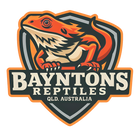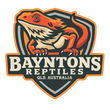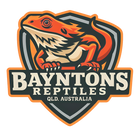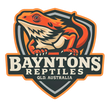Dunner
🔎 Quick Summary (Customer-Friendly)
The Dunner morph is one of the most unique scale and pattern mutations in bearded dragons. Instead of neat, symmetrical scales and markings, Dunners grow with chaotic scale direction, irregular patterns, and scattered colour spots. They look wild, unpredictable, and stand out instantly from normal dragons. Dunner is a staple in many breeding programs because it adds diversity and makes dragons look one-of-a-kind.
📸 Visual Traits & Identifiers
- Scales grow in random directions (sideways, backwards, spiralled)
- Dotted, scattered colour patches across the body and belly
- Jagged, broken barring instead of clean symmetrical lines
- Tail rings are irregular, sometimes broken or spotty
- Beard often shows messy, chaotic colouration
- Overall “busy” look compared to the clean, linear patterns of normal dragons
🧬 Genetic Behaviour & Inheritance
- Genetic Type: Simple Dominant
Pairing Outcomes
- Normal × Dunner = ~50% Dunner, ~50% Normal
- Dunner × Dunner = ~75% Dunner, ~25% Normal
- No such thing as “Het Dunner” — the gene is always visible when present
🧪 Why Breeders Use It
Dunner is loved for its pattern-breaking effect. It adds randomisation, splattered colour, and scattered scales to any line. When combined with bright colour morphs (reds, citrus, purples), it produces some of the most chaotic and striking dragons available. Many collectors choose Dunners because no two ever look alike.
🔁 Popular Morph Pairings
- Dunner × Hypo → Bright, clean tones but chaotic patterning
- Dunner × Trans → Dark, glassy dragons with splattered designs
- Dunner × Red Devil → Fiery, spotted blood-red chaos morphs
- Dunner × Zero → Unique greyscale patternless-with-spots effect
- Dunner × Leatherback → Smooth bodies with disordered patterns
- Dunner × Paradox lines → Enhances unpredictability and oddball traits
⚠️ Important Notes
- Dunner babies may show slower growth rates compared to clean-line siblings (commonly observed, though not scientifically proven)
- Because scales point in all directions, some Dunners shed differently and may need closer monitoring
- Always ensure Dunners are linebred with strong colour foundations — otherwise, the pattern can look “muddy"
💡 Fun Fact
The Dunner gene was first discovered in Germany and named after the breeder Kevin Dunn, who produced the original lines. His work completely changed the look of bearded dragons in the hobby worldwide.
✅ Best Uses in Breeding Programs
- To break up neat barring and produce chaotic, unique looks
- To amplify colour spotting and random splashes in Red, Citrus, or Orange lines
- To create dragons that never look the same as their clutchmates
- To introduce visual diversity in otherwise “clean” morph projects
🔚 Final Word
The Dunner gene is one of the most recognisable and creative morphs in the bearded dragon world. For breeders chasing oddball looks, wild patterns, and pure uniqueness, Dunner is a must-have in any serious project.
🛡️ Proudly Bred & Shared by:
🔥 BAYNTONS REPTILES 🔥
Australia’s Premium Bearded Dragon Genetics
Linebred. Legit. Legendary.
📍 Based in QLD | 🦎 Est. by Brothers | 🔗 [@BayntonsReptiles]



